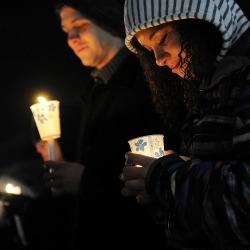A Dreary Mythbuster
BROOKE: And I'm Brooke Gladstone, about to bust a popular media myth. You won't like it. In the last month at least two shootings have made national news:
news clips
Announcer: A scary situation underway right now in Ottawa, the shootings outside the Canadian Parliament, also reports of gunfire inside the halls of Parliament.
Announcer: There has been another school shooting in this country, this time in a high school north of Seattle, in Marysville Washington, where a student started shooting in the school cafeteria.
BROOKE: The DC Navy Yards, Santa Barbara, Aurora, Newtown, shootings resound on the airwaves, occurring with what feels like greater frequency. But that feeling, experts tell us, is wrong.
news clip
Expert: There has been no increase. So it's not an epidemic. It's not on the rise.
Expert: There are so many mass shootings that are happening, not more frequently, but they're getting more attention than ever before...
Expert: We should focus on the trend lines not the headlines.
BROOKE: Would that that were true. But it all depends on how you define a mass shooting. Northeastern University criminologist James Alan Fox, who we just heard, defines a mass shooting as any homicide, including domestic shootings and gang violence, in which four or more are killed with a gun. Defined that way, then yes, the trend line is flat. But those headline-grabbing incidents, a guy with a gun shooting in a place like a school or a theater or a shopping mall, those incidents are increasing. You were right all along. That's according to new research from the Harvard School of Public Health and Northeastern University, in association with Mother Jones. To find the relevant data says data research associate Deborah Azrael, you only have to dis-aggregate the mayhem. To illustrate, she uses a medical analogy.
Azrael: If you look at cancer rates in the United States, they've largely been going down and pretty steadily over the past thirty years, say. There's one really noticeable exception, which is lung cancer rates among women, which have gone up over that period. If we look at cancer rates overall, we will not see this important subgroup of cancers that increasing and try to address those. Similarly, we have the capacity to make sensible subgroups out of that category, four or more people killed with a gun, and to lump them all together we do it at our peril.
BROOKE: So, people wielding a gun in public places, not domestic, not gang-related, those incidents are on the rise?
AZRAEL: Starting in 1982, prior to about 2011, mass public shootings of the sort we've been talking about, came on average about every 172 days. Since some time in 2011, what we see is that they've now been coming on average, about every 64 days.
BROOKE: Why 2011, any guesses?
AZRAEL: We need to figure that out. We know, for example, that the prevalence of mental health issues didn't change in 2011. We didn't have big changes in firearm related laws in 2011. We didn't have big changes in any number of things that might explain it so we have to look more closely. What you really have to understand is far less than 1 percent of all homicides are public mass shootings. One of the reasons you want to sort of parse this out is we're looking at a really rare event that's nonetheless distinct. We want to be able to respond to it.
BROOKE: So do you have a breakdown of the different kinds of shootings? Which have gone up, which have gone down?
AZRAEL: There isn't a good data set. So it's done crudely with circumstance information that's provided by the FBI, or looking at news reports and the like. The good news is, that in the wake of Newtown, one of President Obama's executive orders was to expand the National Violent Death Reporting System which is run by the CDC and collected data on all homicide/ suicides and accidental firearm deaths in the United States. And that data set which was in 18 states and is now in 38 states, collected the kind of detailed information on these incidents that you really would want to know. How many people were killed, how many people were shot and killed. How many people were killed, how many people were shot but not killed, did the shooter kill him or herself and it provides a narrative as to what happened.
BROOKE: How do you suggest we use that information?
AZRAEL: One approach is to really ask ourselves, can we identify something that happened you know around 2010, or 2011, that might plausibly have changed the frequency of these events. Maybe media reporting makes a difference, there's this sort of contagion. We also know that there are changes happening now in response to these shootings. Police have changed the way they intervene. They go in and try to interrupt an event before more people die. Those sorts of things might in fact lead to a shift that would result in them coming less frequently, that's the kind of question we need to be in the position to ask and then to answer as we try to do things now. The other thing we can do is look at domestic homicides. My guess is that those haven't changed very much, that that's what's driving the claim that there hasn't been a change in mass homicides. So why have we not been able to make an impact on those kinds of domestic homicides? If you want to understand any phenomenon, you need to count it carefully, dis-aggregate big groups of deaths into sensible subsets. You don't want to mix apples and oranges.
BROOKE: Deborah thank you very much.
AZRAEL: It's been a pleasure.
BROOKE: Harvard research associate Deborah Azrael, exploding a media myth we really would have preferred to believe.
